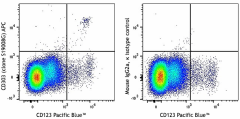Analyte Specific Reagent. Analytical and performance characteristics are not established.
- Clone
- S19008G
- Other Names
- CLEC4C, CLECSF11, CLECSF7, DLEC, HECL
- Isotype
- Mouse IgG2a, κ

-

Typical results from human peripheral blood mononuclear cells stained with S19008G APC used at 5 µL/test (left) or with an isotype control (right), with anti-human CD123 Pacific Blue™ costaining.
| Cat # | Size | Price | Quantity Check Availability | Save | ||
|---|---|---|---|---|---|---|
| 982002 | 500 µL | $370 | ||||
CD303, also known as BDCA-2 and CLEC4C, is a 38 kD type II transmembrane glycoprotein. It is a member of the C-type lectin superfamily. CD303 is expressed by plasmacytoid dendritic cells (pDCs) and is involved in cell adhesion, signaling, and antigen capture and processing. Crosslinking of CD303 inhibits the production of IFN-α/β and TLR-9 induced pDCs maturation.
Product DetailsProduct Details
- Reactivity
- Human
- Formulation
- Phosphate-buffered solution, pH 7.2, 0.09% sodium azide, 0.2% (w/v) BSA (origin USA), and a stabilizer.
- Preparation
- The antibody was purified by affinity chromatography and conjugated with APC under optimal conditions.
- Concentration
- 50 µg/mL
- Storage & Handling
- The antibody solution should be stored undiluted between 2°C and 8°C, and protected from prolonged exposure to light. Do not freeze.
- Application
-
Suggested for Flow Cytometry
- Disclaimer
-
WARNINGS AND PRECAUTIONS
- Use appropriate personal protective equipment and safety practices per universal precautions when working with this reagent. Refer to the reagent safety data sheet.
- This antibody contains sodium azide. Follow federal, state and local regulations to dispose of this reagent. Sodium azide build-up in metal wastepipes may lead to explosive conditions; if disposing of reagent down wastepipes, flush with water after disposal.
- All specimens, samples and any material coming in contact with them should be considered potentially infectious and should be disposed of with proper precautions and in accordance with federal, state and local regulations.
- Do not use this reagent beyond the expiration date stated on the label.
- Do not use this reagent if it appears cloudy or if there is any change in the appearance of the reagent as these may be an indication of possible deterioration.
- Avoid prolonged exposure of the reagent or stained cells to light.
Antigen Details
- Antigen References
-
- Jähn PS, et al. 2010. Cell. Immunol. 265:15.
- Graham LM and Brown GD. 2009. Cytokine. 48:148.
Compare Data Across All Formats
This data display is provided for general comparisons between formats.
Your actual data may vary due to variations in samples, target cells, instruments and their settings, staining conditions, and other factors.
If you need assistance with selecting the best format contact our expert technical support team.
-
Purified anti-human CD303 (BDCA-2) Antibody

Human peripheral mononuclear cells were stained with anti-hu... -
PE anti-human CD303 (BDCA-2) Antibody

Human peripheral mononuclear cells were stained with anti-hu... -
APC anti-human CD303 (BDCA-2) Antibody

Human peripheral mononuclear cells were treated with Human T... -
FITC anti-human CD303 (BDCA-2)

Human peripheral mononuclear cells were treated with Human T... -
PE/Fire™ 810 anti-human CD303 (BDCA-2)

Human peripheral mononuclear cells were treated with Human T... -
APC anti-human CD303

Typical results from human peripheral blood mononuclear cell...
 Login/Register
Login/Register 






Follow Us